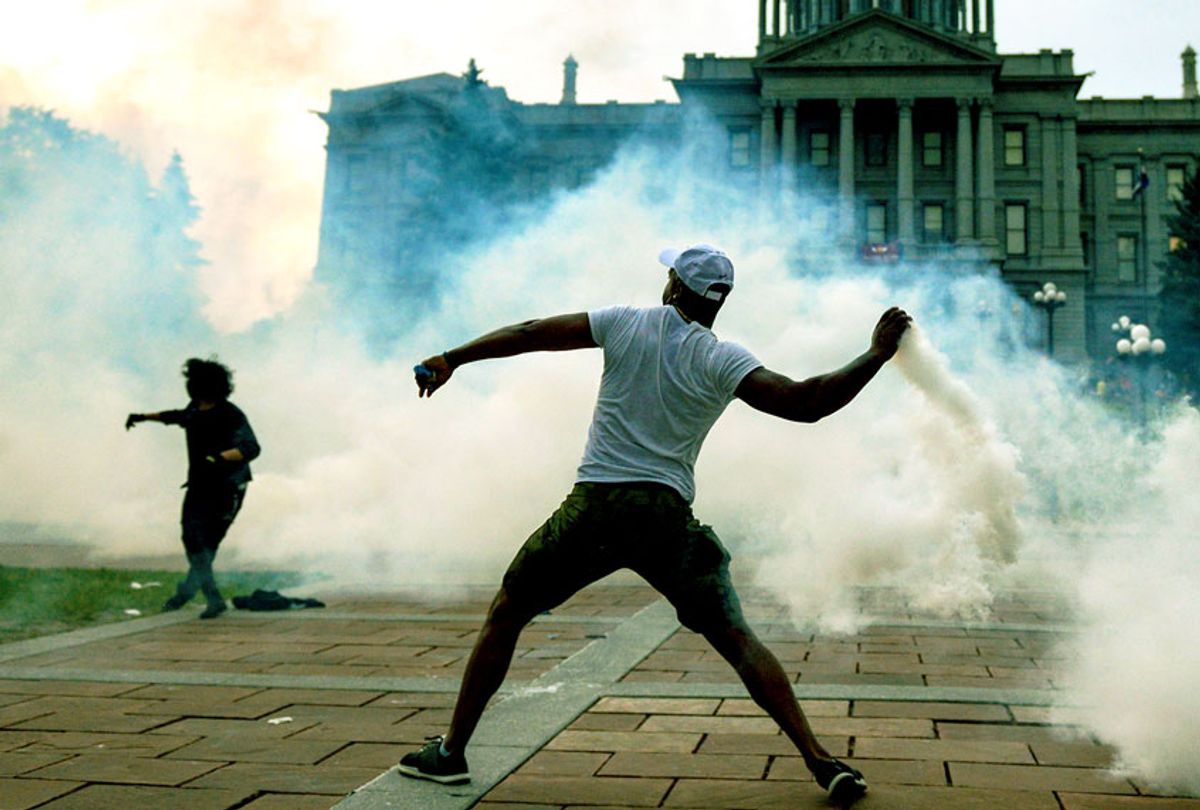As thousands of people fill the streets in cities across the country to protest systemic racism and police brutality against Black Americans, protesters have been met with chemical warfare weapons that have been dubbed too dangerous for war. Tear gas — a class of chemical weapons formally known as lachrymator agents — can cause severe eye damage, blindness, chemical burns, nerve damage, coughing and even respiratory failure for those with preexisting respiratory conditions. The severity of damage after being exposed hinges on how much is dispersed and the proximity to the agent, and whether one is inside or not.
Under normal conditions, tear gas is an extreme and violent form of repression when used against protesters. In the middle of a pandemic involving an oft-fatal respiratory disease — well, doctors are shocked.
"It's very poor timing, I'd say on the part of our public officials to treat protesters, or to deal with protesters with the use of tear gas in the middle of a respiratory pandemic," Dr, Jeanne Noble, an Associate Professor of Emergency Medicine and Director of COVID-19 Response at the University of California–San Francisco, told Salon. "Tear gas is intended to be an irritant to the respiratory system, it causes immediate eye watering sneezing, coughing and the feeling of shortness of breath."
There have been dozens of reports of protesters being attacked with tear gas at protests, sometimes on a nightly basis. In Oakland, Calif., protesters were tear gassed every night since the protests began, Friday through Monday. Tuesday night was the first night without such attacks. Police have been using tear gas on protesters in Kentucky, Minneapolis, Washington DC, Seattle, Austin, Philadelphia, Chicago and more.
Satya Achanta, DVM, PhD, DABT, an assistant professor in the department of anesthesiology at the Duke University School of Medicine explained to Salon the biology of tear gas. Achanta says that tear gas is not exactly a gas, but more accurately actually fine particulate matter — a solid particle that, when exploded into the air, binds with pain receptors and nerve endings.
"When people start feeling the pain or a burning sensation, that's an initial indication that something is going on here," Achanta added. "However, when exposed to higher concentrations of tear gases and for a longer duration, it depends on what results in short term or long term or toxic inflammatory reactions."
Achanta was especially worried about the use of tear gas amid a pandemic.
"In general, I'm concerned about the use of tear gases in the first place. And I am more concerned, particularly in these uncertain times today, where a coronavirus pandemic is going on in the United States, and also around the world."
Achanta said if someone is protesting and has coronavirus but no symptoms, that person is more apt to spread the virus at the protest through tear gas–induced coughing. Likewise, those exposed to tear gas are likely to experience "accelerated toxic effects."
"There will be a cumulative effect," Achanta said. "Because already his lungs are infected and they are diseased, so he will experience higher symptoms." In other words, if a healthy protester is gassed, that person could be more susceptible to COVID-19 because of the inflammation caused by the tear gas.
Achanta said he is especially concerned because marginalized communities have been hit the hardest by COVID-19.
"Usually, I am sad about the use of tear gas, and in these uncertain times with COVID-19, I'm more concerned," Achanta said.
Dr. Noble said the coughing and sneezing that happens immediately after being exposed is a great way to spread the coronavirus.
"When somebody is subjected to tear gas, they immediately want to take off a face mask if they were wearing one —and of course it would be dampened by tear gas so they would have to take it off, and then they cough and sneeze, and really spew a respiratory secretions, respiratory droplets all over anyone who is nearby," Dr. Noble said. "It's a very effective way of spreading the coronavirus . . . . if any of the protesters are asymptomatic or symptomatic carriers, they will be effectively distributing their viral load to all those around them after they're sprayed with tear gas."
She added that in addition to the immediate effect of being exposed to tear gas, it's "akin to having a bad asthma attack." Some studies have found after someone has been exposed to tear gas, they're more likely to succumb to a respiratory illness.
"That is also particularly inopportune in the middle of our COVID epidemic," Noble added. "So to be using a method of crowd control that is going to almost certainly spread COVID-19 among the protesters, and then of course the community at large, is really misguided policy."
Protesting is already a risk in the pandemic, but that risk can be mitigated when everyone is wearing a mask and people keep their distance.
"To take what is already a moderate-risk situation with people protesting, and to make it an incredibly high risk situation by gassing people with tear gas is just ludicrous," Dr. Noble said.

Shares